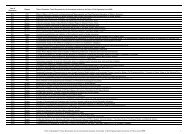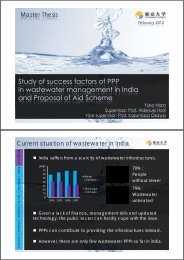Land policy and property price in Hanoi, Vietnam, January 2009
Land policy and property price in Hanoi, Vietnam, January 2009
Land policy and property price in Hanoi, Vietnam, January 2009
Create successful ePaper yourself
Turn your PDF publications into a flip-book with our unique Google optimized e-Paper software.
serious traffic problems, ma<strong>in</strong>ly due to the heavy traffic congestion. The <strong>in</strong>frastructure systemsuch as water supply, sewerage <strong>and</strong> dra<strong>in</strong>ed systems are also <strong>in</strong> shortage. The liv<strong>in</strong>genvironment is undesirable <strong>in</strong> this zone as many lakes or river are polluted.Area built after 1990This zone is located outside the r<strong>in</strong>g road No.2 with 12,966 ha area. It has been develop<strong>in</strong>gunder the market-oriented development dur<strong>in</strong>g the dramatic urbanization of <strong>Hanoi</strong> s<strong>in</strong>ce1990s. It <strong>in</strong>cludes the four urban fr<strong>in</strong>ge districts, namely Tay Ho, Cau Giay, Thanh Xuan <strong>and</strong>Hoang Mai, <strong>and</strong> the urban l<strong>and</strong> area of two suburb districts: Tu Liem <strong>and</strong> Thanh Tri. There arearound 784,000 people liv<strong>in</strong>g <strong>in</strong> this zone (JICA, 2005). Although the current populationdensity <strong>in</strong> this area is still low, it has been grow<strong>in</strong>g at 6.5% of the average annual populationgrowth rate over five past years. Note that the average annual population growth rate is 2.7%<strong>in</strong> <strong>Hanoi</strong> city. One of the reasons for the rapid <strong>in</strong>crease of population is the high rate of urb<strong>and</strong>evelopment of <strong>Hanoi</strong> city <strong>in</strong> this area. Most of these urban development projects are ofmedium size, averag<strong>in</strong>g from 80-100 ha; exceptionally the Ciputra Urban Area has reached to300 ha. The house development projects <strong>and</strong> new urban area projects have been carefullyplanned <strong>and</strong> implemented simultaneously. They strictly followed the master plan with modernhous<strong>in</strong>g network compris<strong>in</strong>g low build<strong>in</strong>gs that are comforted <strong>and</strong> spacious with modernarchitecture. The <strong>in</strong>frastructure system like transportation network, electric power <strong>and</strong> gassupply has been built with high technical st<strong>and</strong>ard. The public services like schools, hospitals<strong>and</strong> open green spaces have also been synchronously designed <strong>and</strong> built, consequentlycreat<strong>in</strong>g a really modern liv<strong>in</strong>g environment for the <strong>Hanoi</strong>an. This area partly has set al<strong>and</strong>mark <strong>in</strong> urban plann<strong>in</strong>g of <strong>Hanoi</strong> <strong>and</strong> attracts people to move <strong>in</strong>to. Together with house<strong>and</strong> office development plans, the new built plann<strong>in</strong>g transportation network has also beenrapidly implemented. Many asphalt-covered major road with the width from 40 to 100 m hasbeen constructed <strong>in</strong> this area. Although the road area ratio is just 6.5% now, it is expected toreach 20% with<strong>in</strong> the next 10 – 15 year period if the implementation is progressed as planned.Outer dyke areaThis zone is located <strong>in</strong> the outer dyke along the Red river. Accord<strong>in</strong>g to the Ord<strong>in</strong>ance ondyke management, any k<strong>in</strong>d of construction is illegal <strong>in</strong> this zone. Nevertheless, people havebeen liv<strong>in</strong>g <strong>in</strong> this area s<strong>in</strong>ce 1950s. At present, the outer dyke area is one of the highestpopulated areas with 17,000 people liv<strong>in</strong>g <strong>in</strong> an area of only 1.018 ha (JICA, 2005). Manyhouses <strong>in</strong> this area are 1-3 story houses built on temporary basis. Dur<strong>in</strong>g the flood season,most of the roads <strong>and</strong> houses are <strong>in</strong>undated under 1.5-3m high flood water. Although the Dariver Hydropower plant was constructed to regulate the flood level, these houses are not onlydamaged by floods every year but also cause problems <strong>in</strong> flood flow <strong>in</strong>creas<strong>in</strong>g the river floodlevel, <strong>and</strong> this results <strong>in</strong> <strong>in</strong>creas<strong>in</strong>g flood risk <strong>in</strong> <strong>Hanoi</strong> City. The road network <strong>in</strong> this zone isnot complete <strong>and</strong> ma<strong>in</strong>ly comprises of scattered crosscut roads. The road area ratio <strong>in</strong> thiszone varies from 3.8 to 6.5% (JICA 2005). The <strong>in</strong>frastructure system is <strong>in</strong>sufficient <strong>and</strong> oftenrequires special ma<strong>in</strong>tenance or upgrad<strong>in</strong>g. Urban residential <strong>and</strong> mixed uses are the dom<strong>in</strong>antl<strong>and</strong> use type. The population is also mixed with employees of government offices,enterprises, traders, <strong>and</strong> self employed workers as well as those liv<strong>in</strong>g on agriculturalactivities.






